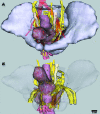Coexistence of adrenergic and cholinergic nerves in the inferior hypogastric plexus: anatomical and immunohistochemical study with 3D reconstruction in human male fetus
- PMID: 19438760
- PMCID: PMC2707089
- DOI: 10.1111/j.1469-7580.2009.01071.x
Coexistence of adrenergic and cholinergic nerves in the inferior hypogastric plexus: anatomical and immunohistochemical study with 3D reconstruction in human male fetus
Abstract
Classic anatomical methods have failed to determine the precise location, origin and nature of nerve fibres in the inferior hypogastric plexus (IHP). The purpose of this study was to identify the location and nature (adrenergic and/or cholinergic) of IHP nerve fibres and to provide a three-dimensional (3D) representation of pelvic nerves and their relationship to other anatomical structures. Serial transverse sections of the pelvic portion of two human male fetuses (16 and 17 weeks' gestation) were studied histologically and immunohistochemically, digitized and reconstructed three-dimensionally. 3D reconstruction allowed a 'computer-assisted dissection', identifying the precise location and distribution of the pelvic nerve elements. Proximal (supra-levator) and distal (infra-levator) communications between the pudendal nerve and IHP were observed. By determining the nature of the nerve fibres using immunostaining, we were able to demonstrate that the hypogastric nerves and pelvic splanchnic nerves, which are classically considered purely sympathetic and parasympathetic, respectively, contain both adrenergic and cholinergic nerve fibres. The pelvic autonomic nervous system is more complex than previously thought, as adrenergic and cholinergic fibres were found to co-exist in both 'sympathetic' and 'parasympathetic' nerves. This study is the first step to a 3D cartography of neurotransmitter distribution which could help in the selection of molecules to be used in the treatment of incontinence, erectile dysfunction and ejaculatory disorders.
Figures







References
-
- Arango-Toro O, Domenech-Mateu JM. Development of the pelvic plexus in human embryos and fetuses and its relationship with the pelvic viscera. Eur J Morphol. 1993;31:193–208. - PubMed
-
- Arango Toro O, Domenech Mateu JM. [Anatomic and clinical evidence of intrapelvic pudendal nerve and its relation with striated sphincter of the urethra] Acta Urol Esp. 2000;24:248–254. - PubMed
-
- Baader B, Herrmann M. Topography of the pelvic autonomic nervous system and its potential impact on surgical intervention in the pelvis. Clin Anat. 2003;16:119–130. - PubMed
-
- Baljet B, Drukker J. Some aspects of the innervation of the abdominal and pelvic organs in the human female fetus. Acta Anat (Basel) 1982;111:222–230. - PubMed
MeSH terms
LinkOut - more resources
Full Text Sources
Other Literature Sources

